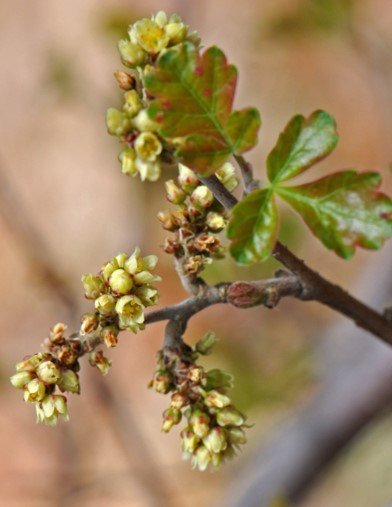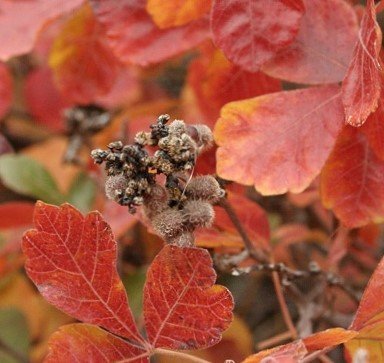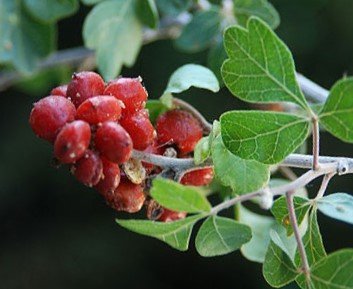 Image 1 of 4
Image 1 of 4

 Image 2 of 4
Image 2 of 4

 Image 3 of 4
Image 3 of 4

 Image 4 of 4
Image 4 of 4





Rhus trilobata (Sourberry or Lemonade Sumac)
Sourberry is a low-growing, variable deciduous shrub native to the eastern and southern parts of our region that is terrific for enhancing habitat, especially as part of a hedgerow or living screen.
Sourberry"s growth habit varies, from upright to spreading; it may be as short as 3-4 ft., though typically reaches 5-6 ft. tall. Its spread varies from 2-8 ft., depending on its placement in the landscape.
A great source of year-round beauty in the landscape, with chartreuse spring flowers that ripen to slightly sticky, edible red summer fruits, and fall color in yellow, orange, and red hues. However, its real draw is the number of wildlife species it supports: from bees and butterflies to small mammals and game birds, this plant has something for everyone! It’s also a long-time medicinal with a wide range of benefits for humans.
Use as an informal hedge in a mass planting, mixed with native and waterwise plants to make a hedgerow, or as a featured plant in a naturalistic planting. Best in full sun to light shade, it can thrive in almost any soil, including sandy/rocky and clay! Its adaptability to many conditions also make it a useful plant for hillside plantings and soil stabilization projects. It is fully drought tolerant once established.
Note: This Rhus is not related to poison sumac and will not cause skin irritations.
Sourberry is a low-growing, variable deciduous shrub native to the eastern and southern parts of our region that is terrific for enhancing habitat, especially as part of a hedgerow or living screen.
Sourberry"s growth habit varies, from upright to spreading; it may be as short as 3-4 ft., though typically reaches 5-6 ft. tall. Its spread varies from 2-8 ft., depending on its placement in the landscape.
A great source of year-round beauty in the landscape, with chartreuse spring flowers that ripen to slightly sticky, edible red summer fruits, and fall color in yellow, orange, and red hues. However, its real draw is the number of wildlife species it supports: from bees and butterflies to small mammals and game birds, this plant has something for everyone! It’s also a long-time medicinal with a wide range of benefits for humans.
Use as an informal hedge in a mass planting, mixed with native and waterwise plants to make a hedgerow, or as a featured plant in a naturalistic planting. Best in full sun to light shade, it can thrive in almost any soil, including sandy/rocky and clay! Its adaptability to many conditions also make it a useful plant for hillside plantings and soil stabilization projects. It is fully drought tolerant once established.
Note: This Rhus is not related to poison sumac and will not cause skin irritations.
